| Examples (Click to see root locus for each Transfer Function) | ||||
|---|---|---|---|---|
 |
 |
 |
 |
 |
This document will discuss the derivation of rules for
sketching the root locus. It is not necessary to understand all of these in
order to do the sketches, but it can be helpful to understand whence come the various
rules. Instead of presenting examples in this document, there are links
to files that contain five separate examples. After each rule, you can select
the link for each of the five examples, and the application of that specific rule
to the selected rule is displayed (along with a brief discussion). Each of
the five
examples can also be examined in its entirety by clicking on the link below.
Note: the example files are edited versions of web pages generated automatically
with a MatLab script, RLocusGui.
To sketch a root locus there are several techniques that can be used as a guide. Not all of these are applicable to all loci. The steps used to sketch a root locus plot are enumerated below:

The closed loop transfer function of the system shown is

So the characteristic equation is

We can write the loop gain as a ratio of polynomials, (we will assume K>0, a0>0, b0>0; generally a0=1). N(s), the numerator polynomial, is defined to be mth order; D(s) is nth order. N(s) has zeros at zi (i=1..m); D(s) has zeros at pi (i=1..n). Note the zeros of D(s) are the poles of the loop gain. The difference between the orders of the numerator and denominator polynomial, n and m, is q, so q=n-m. We assume here that the transfer function is proper - in other words q≥0.
 ,
,
or we can write the loop gain in its factored form:

As K changes, so do locations of closed loop poles (i.e., zeros of characteristic equation).
It is convenient for the derivation of many of the rules that follow to rewrite the characteristic equation as follows.

Many of the rules discussed below come from two conditions imposed by the characteristic equation. Since this equation involves a complex quantity both the magnitude and phase of the two sides of the equation must be equal.
The magnitude condition is expressed as

Since K≥0, we can rewrite this as

The phase angle is expressed as

Since K≥0, it has a phase of 0° and can be ignored. The angle of -1 is any odd multiple of 180°.

| Magnitude Condition | Phase Condition |
 |
 |
Note: an alternate set of rules, for K<0 can be derived; this is referred to as the complementary root locus.
The loop gain is KG(s)H(s) which can be rewritten as KN(s)/D(s).
N(s), the numerator polynomial, is mth order; D(s)
is nth order:

K>0, a0>0, b0>0.
N(s) has zeros at zi (i=1..m); D(s) has zeros
at pi (i=1..n):
 .
.
The difference between n and m is q, so q=n-m.
| Examples
(Click on a Transfer Function below and then scroll down on the page that opens to see this rule, and others, applied) |
||||
|---|---|---|---|---|
 |
 |
 |
 |
 |
Since the characteristic equation has real coefficients, any zeros must occur in complex conjugate pairs (which are symmetric about the real axis). Since the root locus is just a diagram of the roots of the characteristic equation as K varies, it must also be symmetric about the real axis.
The Root locus is symmetric about the real axis.
Since the root locus is just a diagram of the roots of the characteristic equation as K varies, and the order of the characteristic equation is the same as that of the denominator of the loop gain. Thus, the number of branches is n, the order of the denominator polynomial.
The number of branches of the root locus is equal to the order of characteristic equation.
| Examples
(Click on a Transfer Function below and then scroll down on the page that opens to see this rule, and others, applied) |
||||
|---|---|---|---|---|
 |
 |
 |
 |
 |
Start from the magnitude condition:

It is apparent that if K→0, the only way the left hand side of the equation can be equal to 1 is if the quantity in the absolute value goes to infinity. This happens when D(s)→0. So the poles of the loop gain (D(s)=0) are the starting points for the loci (when K=0).
It is also apparent that if K→∞, the only way the left hand side of the equation can be equal to 1 is if the quantity in the absolute value goes to zero. This happens when N(s)→0, and it also happens as s→∞ if the order of the denominator is greater than the order of the numerator. So the zeros of the loop gain (which occur at N(s)=0, and perhaps as s→∞) are the ending points for the loci (when K→∞).
The locus starts (when K=0) at poles of the loop gain, and ends (when K→∞ ) at the zeros. Note: there are q zeros of the loop gain as s→∞ .
| Examples
(Click on a Transfer Function below and then scroll down on the page that opens to see this rule, and others, applied) |
||||
|---|---|---|---|---|
 |
 |
 |
 |
 |
Start from the angle condition:

Write out the ratio of polynomials:

We will take a0>0, b0>0 (generally a0=1), so:

So the angle criterion can be restated as:

Now consider the angle between a point "s" (the red vector) on the real axis, and a point "z" (the blue vector) that is also on the real axis. The diagrams below show the vector "s-z" f(the green vector) or the case when "s" is to the left of "z," and when s is to the right of z. (Review: How to subtract vectors).
 |
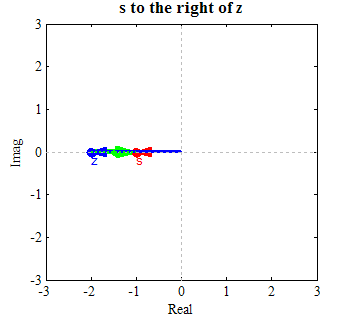 |
In both figures, "s" is shown by a red vector, and "z" is shown by a blue vector. The difference can be found by drawing a vector from the point "z" to the point "s," which is shown by a green vector. When "s" is to the left of "z" (left diagram), the angle of the vector "s-z" is 180° (or any odd multiple of 180°). When "s" is to the right of "z" (right diagram), the angle of the vector "s-z" is 0° (or any even multiple of 180°).
However, we still need to consider complex conjugate poles and zeros. To see their contribution, consider the diagram below.

In this diagram the vector "s" is red, "z" and its conjugate "z*" are blue and "s-z" and "s-z*" are green. Clearly the angle contributions from "z" and its conjugate "z*" (shown in dotted green) are equal and opposite, and so cancel each other out. Therefore we need not consider the contribution of complex conjugate zeros, or poles; we need only consider the contribution of zeros and poles that are on the real axis.
Now reconsider our statement of the angle criterion:

This equation indicates that any zeros to the left of a quantity "s" on the real axis contributes 180°, a pole to the left will contribute -180°, but a pole or zero to the right of "s" on the real axis contributes 0°. Since the sum of angle contributions from zeros on the real axis minus the sum of contributions from poles on the real axis is an odd multiple of 180°, this indicates that if a point "s" on the real axis will only be on the locus if it is to the left of an odd number of zeros and poles that are on the axis.
The locus exists on real axis to the left of an odd number of poles and zeros on the axis.
| Examples
(Click on a Transfer Function below and then scroll down on the page that opens to see this rule, and others, applied) |
||||
|---|---|---|---|---|
 |
 |
 |
 |
 |
If q>0 (in other words, the denominator polynomial of the loop gain is of higher order than is the numerator), then the loop gain has q zeros as |s|→∞ . We will show that we can make some simple approximations that will describe the behavior of the closed loop poles as |s|→∞ . If q=0, you need not do this step.
First we will do a very simple approximation to study behavior of the root locus as |s|→∞ . Consider the characteristic equation.

We can rewrite this, and then if we let |s|→∞ , all but the highest order terms of the polynomials go become insignificant.

Now we can apply the angle criterion

Now we can write "s" as

and complete the derivation

K, a0, b0 and M are all positive so they don't contribute to the angle, so

To summarize: as |s|→∞ , the loci are asymptotic to a set of lines that that radiate outward from the origin with angles of θ=±r180°/q where r=1, 3, 5...

If this isn't obvious, consider a positive number, β, with

Now use the polar form of "s,"
 ,
,
and we get

Since the number is complex, both the magnitude and phase must be equal.
Consider first the magnitude.

This tells us that as β goes from 0 to infinity, so does the magnitude of "s."
Now consider the phase.
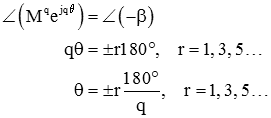
This tells us that the angle of "s" is given by ±r180°/q, where r=1, 3, 5...
Taking both the magnitude and phase into consideration this shows that

is represents lines emanating from the origin at equally spaced angles as β goes from 0 to ∞ .
In the approximation above, we kept only the highest order term of the numerator and denominator polynomial as |s|→∞ . We can get a better approximation if we keep the two highest order terms. Let's start with the factored form of the loop gain, and multiply it out:
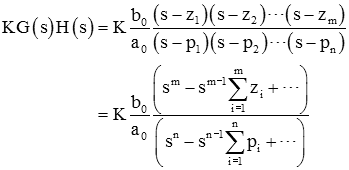
I have only written out the two highest order terms of the polynomial. If the second term in the polynomial is not obvious, then examining the case of a third order polynomial should make it obvious.

(The equation on the second line agrees with our result.)
Now let's do some manipulations to get this into a more useful form. First, we let |s|→∞ and only keep the two highest order terms of the polynomials.
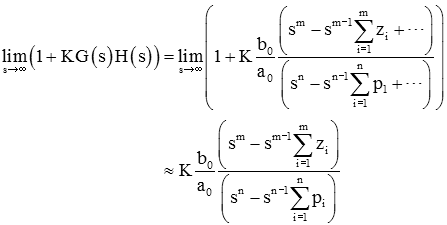
We can multiply the numerator and denominator by the same term. This simplifies the numerator.
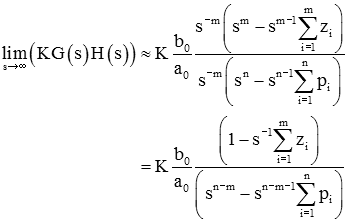
Note that the second term in the numerator polynomial is small, so we can use the binomial approximation.
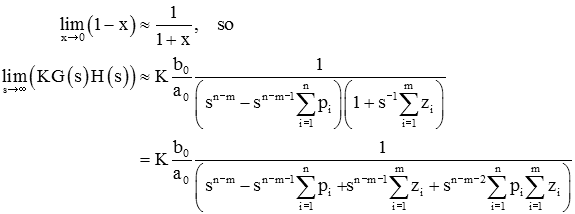
Keep only the highest order terms from the denominator polynomial (since |s|→∞ ):
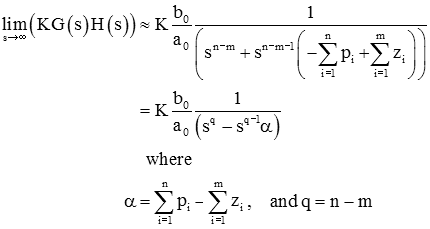
Now we note that a polynomial with repeated roots is given by


Again, if this isn't obvious, consider the third order case (which generalizes to higher order):

As |s|→∞ we can, again, simplify this by keeping only the highest order term

This is expression has the same form as the one in the denominator of the expression we just derived (i.e., loop gain as |s|→∞). We can make the substitution:

our expression for the loop gain as |s|→∞ becomes

Putting this back into our expression for the characteristic equation we get (as |s|→∞ ):

This represents a set of vectors that intersect the real axis at s=-σ, that radiate outward with angles of θ= ±r180°/q where r=1, 3, 5...
 as s→∞ .
as s→∞ .Since

represents lines emanating from the origin at equally spaced angles as β goes from 0 to ∞ , then the expression

is just shifted by σ. In other words, it represents lines emanating from σ at equally space angles.
This tells us that the locus is asymptotic to these lines because both the locus and (s-σ)q have the same form as |s|→∞ .
If q>0 there are asymptotes of the root locus, and...
asymptotes intersect real axis
at  ,
,
asymptotes radiate out with
angles  , where
r=1, 3, 5…
, where
r=1, 3, 5…
| Examples
(Click on a Transfer Function below and then scroll down on the page that opens to see this rule, and others, applied) |
||||
|---|---|---|---|---|
 |
 |
 |
 |
 |
To find where the locus breaks away from the axis (or converges on the axis), we note that this always occurs when two (or more) roots intersect. It is a well know fact, that when a polynomial has multiple roots, not only is the value of the polynomial zero, but its derivative is zero also (Background).
Start by considering the characteristic equation

At the break-away (and -in) points, the derivative of the characteristic equation is also zero.

If we simplify this we get:

I prefer to switch the order of the subtraction (though it really makes no difference),
 .
.
There are break-away or -in points of the locus on the real
axis wherever  .
.
Note: Many times, especially for simple root loci, there are no
break-away or break-in points. In these cases, this step is not necessary.
Additionally this will find break-away and break-in points at any repeated poles and zeros that are on the real
axis. For example if N(s)=(s+1)^2 so that N'(s)=2(s+1), then both N(s)=0 and N'(s)=0 at s=-1, so this criterion
will indicate a break-in point at s=-1 even if one doesn't exist.
| Examples
(Click on a Transfer Function below and then scroll down on the page that opens to see this rule, and others, applied) |
||||
|---|---|---|---|---|
 |
 |
 |
 |
 |
If the loop gain, G(s)H(s), has a simple pole on the real axis, we know that the locus will leave from the pole, as K→0, along the axis. However, if the pole is complex it can leave at any angle. To find the angle at which the locus leaves a complex pole, we start from the re-stated angle criterion (from the "Locus on Real Axis" rule):

To find the angle at which the locus leaves from the pole pj, we can rewrite the angle criterion by isolating the angle between the locus and pj.

or

In this equation we have taken r=1 since the solutions are the same for all values of r. Now if we consider a point "s" on the locus that is very close to pj, then all the terms on the right hand side can be approximated by the angle between the pole or zero and pj. In other words, if "s" is very close to pj, then we can approximate the angle criterion as:

This is demonstrated by an example, below which shows a Root Locus plot of a function G(s)H(s) that has one zero at s=-1, and three poles at s=-2, and s= -1±j. :

To find the angle of departure from the pole at s=-1+j (which we will call p2), we choose a point on the locus very near p2 and then find the angles from the zero and the other poles.

The angle of departure (135°) is shown in grey on the diagram.
The angle of departure from a complex pole, pj, is 180 degrees + (sum of angles between pj and all zeros) - (sum of angles between pj and all other poles).

Note that this rule does not work as stated if the pole is repeated (for example the polnomial
$${s^2} + 2s + 1 = {\left( {s + 1} \right)^2} = 0$$
has a repeated root at s=-1).
Note: Many times, especially for simple root loci, there are no complex poles in loop gain. In these cases, this step is not necessary.
| Examples
(Click on a Transfer Function below and then scroll down on the page that opens to see this rule, and others, applied) |
||||
|---|---|---|---|---|
 |
 |
 |
 |
 |
This follows closely the derivation for the previous rule ("Angle of Departure") and will be brief.
If the loop gain, G(s)H(s), has a simple zero on the real axis, we know that the locus will arrive at the zero, as K→∞ , along the axis. However, if the zero is complex it can arrive at any angle. To find the angle at which the locus arrives at a complex zero, we start from the re-stated angle criterion (from the "Locus on Real Axis" rule):

To find the angle at which the locus arrives from the pole zj, we can rewrite the angle criterion as

or

In this equation we have taken r=1 since the solutions are the same for all values of r. Now if we consider a point "s" on the locus that is very close to zj, then all the terms on the right hand side can be approximated by the angle between the pole or zero and zj. In other words, if "s" is very close to zj, then we can approximate the angle criterion as:

The angle of arrival at a complex pole, zj, is 180 degrees + (sum of angles between zj and all other zeros) - (sum of angles between zj and all poles).

Note that this rule does not work as stated if the zero is repeated (for example the polynomial $${s^2} + 2s + 1 = {\left( {s + 1} \right)^2} = 0$$ has a repeated root at s=-1).
Note: Many times, especially for simple root loci, there are no complex zeros in loop gain. In these cases, this step is not necessary.
| Examples
(Click on a Transfer Function below and then scroll down on the page that opens to see this rule, and others, applied) |
||||
|---|---|---|---|---|
 |
 |
 |
 |
 |
If it becomes apparent that the root locus crosses the imaginary axis (i.e., it is unstable for some values of K), use a technique such as Routh-Horwitz to find where the locus crosses the imaginary axis (i.e., the frequency of oscillation when it becomes unstable).
Use Routh-Horwitz to determine where the locus crosses the imaginary axis.
Note: Many times, especially for simple root loci, the root locus does not cross the imaginary axis, or does so along the real axis. In these cases, this step is not necessary.
| Examples
(Click on a Transfer Function below and then scroll down on the page that opens to see this rule, and others, applied) |
||||
|---|---|---|---|---|
 |
 |
 |
 |
 |
Recall that the characteristic equation can be written in the form:

or

The values a0...an and b0...bm are all known. So given a value of K we can determine the resulting polynomial and factor it to find the roots of the characteristic equation (this may require a computer).
Rewrite characteristic equation as D(s)+KN(s)=0. Put value of K into equation, and find roots of characteristic equation.
Note: Many times this step is not necessary.
| Examples
(Click on a Transfer Function below and then scroll down on the page that opens to see this rule, and others, applied) |
||||
|---|---|---|---|---|
 |
 |
 |
 |
 |
Recall that the characteristic equation can be written in the form:

or

So, given a value of "s" that is on the locus, it is possible to solve for the corresponding value of K.
Note that if the value of "s" is obtained by inspection of a root locus plot, it is only approximate. If the chosen value does not actually lie on the locus, the resulting value of K may be complex. If this happens, the imaginary part will be small, so just take the imaginary part of K. You should then use this value of K (see above) to find the exact value of the root location.
Rewrite characteristic equation as
 , replace "s" by the desired pole location
and solve for K.
, replace "s" by the desired pole location
and solve for K.
Note: Many times this step is not necessary, especially when the task is simply to draw the root locus.
| Examples
(Click on a Transfer Function below and then scroll down on the page that opens to see this rule, and others, applied) |
||||
|---|---|---|---|---|
 |
 |
 |
 |
 |